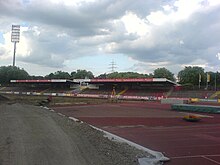Underfloor heating

A soil heating is a technical device to the turf from sports stadiums to keep even in freezing temperatures playable.
function
For this purpose, according to the principle of underfloor heating , a close-meshed network of pipes is laid under the lawn, through which warm water is passed if necessary to thaw the space. This requires around 30 kilometers of plastic loops, which are laid at a distance of 30 centimeters across the playing field. The installation of underfloor heating costs around 400,000 to 800,000 euros (including the necessary replacement of the lawn). The cost of the assignment varies. Alemannia Aachen puts the costs at “[…] 1500 euros per week, at VfL Osnabrück the price for a playable field […] is almost 2000 euros per day. Hansa Rostock names 3,000 euros per day, Hallesche FC 1,000 euros. "
By using turf heating, the indoor area of the sports stadium can also be used in winter and weather-related failures can be significantly reduced. Hardly frozen ground is thawed and (not too thick) blankets of snow melted. Many professional sports clubs have also equipped their training grounds with underfloor heating so that they can train under regular conditions even in winter.
Germany
The first underfloor heating in Germany was installed in the Munich Olympic Stadium in 1972 , and the Waldstadion in Frankfurt followed a few years later . In the 1990s, the subject of underfloor heating became relevant again. When modernizing stadiums, turf heating was usually installed at the same time.
Since the 2007/2008 season, every stadium in the Bundesliga and the 2nd Bundesliga must be equipped with turf heating. There are no transition periods.
The statute of the 3rd league provides for turf heating as a prerequisite for admission, but allows “in particularly justified exceptional cases, e.g. B. for promoters from the 4th league level ", an exemption. For example, the underfloor heating in the Hänsch arena in SV Meppen was only installed during the summer break after the 2017/18 promotion season in order to meet the conditions for the next third division season.
In the regional leagues , for example, the stadiums in Aachen and Essen are equipped with turf heating.
Austria
Since the 2016/17 season, every club in the Austrian Bundesliga has to have underfloor heating or specify an alternative stadium with underfloor heating when licensing. Underfloor heating is currently installed in the following Bundesliga stadiums: Ernst Happel Stadium (Vienna), Allianz Stadium (Vienna), Generali Arena (Vienna) , Red Bull Arena (Wals-Siezenheim) , Merkur Arena (Graz), Linzer Stadion ( Linz, alternative stadium), NV Arena (St. Pölten), Cashpoint Arena (Altach). In the second division, the following stadiums have underfloor heating (list may be incomplete): Tivoli-Neu (Innsbruck), Linzer Stadion and Das.Goldberg-Stadion (Grödig).
Lawn cooling
In order to be able to operate an ice rink on the sunbathing lawn in winter , a test field with lawn cooling was set up in the Eglisee swimming pool in Basel in 2011. Although the cooling functioned in principle, the pilot test was canceled due to the significantly higher water requirement of the lawn in summer and the planned system was not installed.
Web links
- Information on the function of underfloor heating (PDF, 976 kB)
Individual evidence
- ↑ NOZ , January 21, 2013
- ^ German Football League (Ed.): Licensing Regulations (LO), Appendix VI - Rules for stadiums and security . December 13, 2017, p. 33 (Art. 37 Para. 3) ( dfl.de [PDF]).
- ^ German Football Association (ed.): Statute 3rd League . S. 92 ( dfb.de [PDF]).
- ↑ Underfloor heating in the Hänsch Arena completed. focus online, accessed on July 31, 2018 .
- ^ Peter Knechtli: Eglisee: Patented ice rink invention in the state enterprise. In: onlinereports.ch. July 6, 2011, accessed February 3, 2018 .
- ↑ Artificial ice rink under natural grass: Basel's pioneering facility works. In: Basellandschaftliche Zeitung . April 7, 2012, accessed February 3, 2018 .
- ^ Peter Knechtli: The failed ice rink revolution on the Egliseebad sunbathing area. In: onlinereports.ch. February 15, 2017, accessed February 3, 2018 .